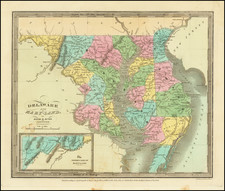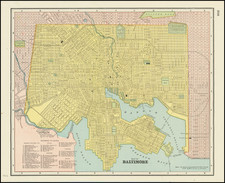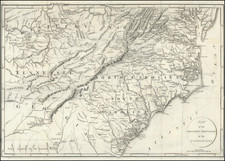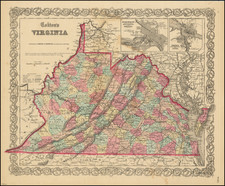Christopher Browne's Map of the Chesapeake & Delaware Bay Regions -- The First Map to Accurately Depict The Boundary Line Which Settled The Penn-Calvert Boundary Dispute, Which Would Become The Mason-Dixon Line
Rare second state of Christopher Browne's seminal map of the Chesapeake Bay, Delaware Bay, Virginia, Maryland, and part of Pennsylvania and New Jersey, one of the most important maps of the region in the latter part of the 17th Century.
The map is the earliest printed map to locate the boundary line established by King James II, which divided Pennsylvania and Maryland and which created the three Lower Counties (Delaware). The line would remain in dispute between the Penn Family and the Calvert (Lord Baltimore) Family until the matter was finally settled over six decades later and ultimately surveyed by Mason and Dixon.
Philadelphia appears on the map. The northern and eastern boundaries of Maryland are shown. The boundary for Delaware (then part of Pennsylvania) is shown, which was finally ratified by the British courts when the dispute was settled in the 1730s. New Jersey is divided into East and West Jersey.
The cartouche depicts tobacco and shellfish, two of the most significant products of the region during colonial times.
Browne's map is considered the most important map of the Chesapeake published in the late seventeenth century. It incorporates the data from Augustine Herrman's unobtainable landmark map of Maryland and Virginia (1673), to which Browne adds more recent information, including the founding of the Proprietorship of Pennsylvania.
A comparison of this map to the maps of Thornton & Greene's A Mapp of Virgina Mary=land, New=Jarsey New=York, and New England . . . (1678 ca); Thornton, Morden and Lea's A New Map of New England New York New Iarsey Pensilvania Maryland and Virginia (1685), and Thornton and Fisher's Virginia, Maryland, Pennsilvania, East & West New Iarsey . . . (1689), shows that Browne's map is both the most faithful and accurate depiction of the original Augustine Herrman map and also the most cartographically advanced.
Origins of the Map
Burden opines that Christopher Browne (fl. 1688-1712 , d. after 1737) most likely prepared the present map as an improvement over the Speed map of Virginia and Maryland, engraved by Francis Lamb in 1676. Browne had acquired the plate for Speed's map from Thomas Bassett and Richard Chiswell, or via Robert Walton, as part of his acquisition of the maps from Speed's world atlas. While Augustine Herrman's map was unquestionably the best available at the time, it was too large to be sold widely in the mass market. This left an opportunity for Browne to produce his map of the Chesapeake region.
Burden outlines a compelling theory for the impetus for the map:
The author believes Browne saw that the interest was high in this region but that there was a lack of maps to supply the demand. Augustine Herrman's map of 1673[74] was too large for most practical situations, the only other competition known was that of John Thornton and Robert Greene issued c.1678. Greene died in 1688, and one can imagine that his death might have caused a disruption to the map's availability. Browne's own plate from the Speed was not the most accurate. Although it did utilise the superior nomenclature of Hemnan, it relied upon John Smith outlines from 1612. The Browne state is exceedingly rare.
While Burden dates the map as circa 1692, the historical facts surrounding the existence and creation of the map offer conflicting evidence. Most prior historians placed the dating of the map at 1685, corresponding with the year in which King Charles II first ruled on the Penn-Calvert Boundary Dispute. However, we think it more likely that the map was created shortly after December 10, 1688, when King James II confirmed the three Lower Counties (Delaware) to the Penn Family by decree, shortly before the Glorious Resolution resulted in the ouster of King James II and the installation of King William in his place.
The Penn-Calvert Boundary Dispute: early colonies
The Penn-Calvert boundary dispute (also known as Penn vs. Baltimore) was a long-running legal conflict between William Penn and his heirs on one side, and Charles Calvert, third Baron Baltimore, and his heirs on the other side. The overlapping nature of their charters of land in Colonial America required numerous attempts at mediation, surveying, and intervention by the king and courts of England to ultimately be resolved, ending with the survey of the line by the surveyors Charles Mason and Jeremiah Dixon between 1763 and 1767. Subsequent questions over these charters have also been adjudicated by American arbitrators and the Supreme Court of the United States. The boundary dispute shaped the eventual borders of five U.S. states: Pennsylvania, Maryland, Delaware, New Jersey, and West Virginia.
In 1629, Samuel Godin and Samuel Blommaert sent agents of the Dutch West India Company to purchase land on Cape Henlopen, near present-day Lewes, Delaware. A new colony named Zwaanendael was established on the purchased land in 1631 by David Pietersz de Vries. The colony proved to be very short-lived, as conflicts with the Nanticoke led to it being wiped out within a year. A second attempt at establishing a colony at that location in 1632 was soon abandoned.
On June 20, 1632, King Charles I granted Cecil Calvert, second Baron Baltimore, a charter for land along the Chesapeake Bay. The northern boundary of the charter was the 40th parallel, and the eastern boundary was the Delaware Bay and the Atlantic Ocean. However, the charter only granted the Calverts the right to "uncultivated" lands. The colonists arrived in Maryland in 1634, but made no attempts at surveying the northern border or colonizing the area along the Delaware Bay.
The colony of New Sweden was established north of the Delaware Bay, at Fort Christina, near present-day Wilmington, Delaware, in 1638. Viewing this as an incursion into their territory, the Dutch established a new outpost in 1651, Fort Casimir at present-day New Castle, Delaware, south of Fort Christina. The Swedes conquered Fort Casimir in 1654, but Peter Stuyvesant, the Director-General of New Netherland, retaliated and in 1655, he both took Fort Casmir and Fort Christina. Stuyvesant renamed Fort Casimir as New Amstel, and placed a deputy there to oversee the entire region who reported back to Stuyvesant at New Amsterdam.
The English objected to the colonization attempts of both Sweden and the Netherlands and Maryland sent a delegate to New Amstel in 1659 protesting their presence on the land granted to Lord Baltimore. However, it wasn't until 1664 when the English formally acted against their colonial rivals. That year, King Charles II granted his brother James, the Duke of York, all the land between the Connecticut and Delaware Rivers. Fort Amsterdam was captured on September 8, 1664, and Stuyvesant formally surrendered the territories of New Netherland the next day. The colonial outposts along the Delaware Bay surrendered soon after, and New Amstel was renamed New Castle by the English. The settlement was still governed by a deputy reporting to New Amsterdam-now called New York, after the Duke, although the Duke had not received a charter from the King for these lands.
In 1681, William Penn was granted a charter for Pennsylvania by Charles II. Lord Baltimore (Charles Calvert) did not object to the grant, as long as Penn's land was north of Maryland's northern border, the 40th parallel. In addition, James was allowed to retain the lands around New Castle that he had won through conquest, causing Charles to carve out a Twelve-Mile Circle around New Castle. Penn, who desired ocean access for his colony, convinced James to lease these lands to him as well, and so in August 1682, the Duke of York granted Penn the Twelve Mile Circle around New Castle as well as the lands south, to Cape Henlopen. Though James had deeded these lands to Penn, James himself did not formally receive a charter to the Delaware lands until March 22, 1683.
Penn sailed to the colonies and, in May 1683, met with Calvert in New Castle. The two men disagreed on how the boundaries should be determined, including where the southern boundary of Pennsylvania should be and how the size of the Twelve Mile Circle should be judged. This meeting marked the beginning of a long legal dispute.
The Penn-Calvert Boundary Dispute: conflicting boundaries
Penn wanted his new colony to have access to the Chesapeake Bay, while Calvert was adamant that the 40th parallel should serve as the southernmost border of Pennsylvania and that the lands on the Delaware Bay were included in the original 1632 charter for Maryland. Because the two could not agree, Penn decided to go to court. Both Penn and Calvert returned to England to participate in the case. By this time, the Duke of York had ascended to the throne as James II. Penn thought his chances in court were good, as he and James were friends and allies. He invoked the Zwaanendael Colony in making his case: the Maryland charter was only for "uncultivated" lands, but the Dutch had cultivated the area near the Delaware Bay by founding a colony that predated the charter. This argument had also been made by the Dutch themselves when Maryland protested the colony in 1659. This proved to be the decisive point.
The Committee for Trade and Plantations agreed that Baltimore's charter was only for uncultivated land, and the presence of Christians in the disputed territory prior to, and after, his settlement of the region meant it could not be his. On November 7, 1685, James issued a decision which called for a compromise. He ordered that the land between the Chesapeake and Delaware Bays be divided in half, with a line west from Cape Henlopen intersecting with a line drawn south from the 40th parallel. James kept the northern border of Maryland at the 40th parallel. Calvert still did not have the border surveyed, however. On December 10, 1688, King James gave Penn a new and more defined charter for the Delaware holdings.
Shortly thereafter, King James was replaced by King William during the Glorious Revolution. William III terminated the colonial grant given to the Calvert Family in 1689 and claimed Maryland as a Royal Colony in 1691. Maryland would remain a Royal Colony for the next several decades, before the Calvert Family's grant was restored. Similarly, in 1691, the Penn charter was also suspended by King William for a period of three years. As such, from 1691 to 1694, King William controlled both colonies and both the Penn and Calvert families had no colonies to promote.
Dating the Map
Based upon the foregoing, we believe the creation of the map would most likely have occurred between December 10, 1688 (the date of the revised charter granting the three Lower Counties to William Penn) and 1691 (when the Penn grant was suspended).
The laying down of the line which approximates the ruling on the Penn-Calvert Boundary dispute would have first been possible and relevant in 1685, following the ruling of the Committee for Trade and Plantations. However, the map includes information drawn from two contemporary sources which suggest a date sometime after January 1688. In the area around Philadelphia, the map incorporates information contained on Thomas Holme's six sheet Map of the Improved Part of the Province of Pennsilvania . . . , which had been engraved by Francis Lamb and published by Robert Greene and John Thornton, and had been first advertised for sale in January 1688. Moreover, the similarities in the two titles (Improved Parts of Pennsylvania) strongly suggests a correlation in both time and, perhaps, mapmaker.
The second contemporary source for the map is John Reid's East Jarsey in America, published in London circa 1687. Specifically, the details in East Jersey set forth in Browne's map, including the identification of Perth (Amboy) and rivers and other features in East Jersey, would seem to have been drawn directly from Reid's map pr a common source.
The presence of the Penn-Calvert boundary line (a decision resolved in William Penn's favor), the "Improved Parts of Pennsilvania" (Penn's Colony), and the improvements in the Quaker colony of New Jersey (in which Penn had been active since the 1670s), strongly points to the reason for publication of the map: the desire to promote emigration and settlement in the region.
Only one other map published in this time period includes both the newly settled Penn-Calvert Boundary Line and the John Reid information. Robert Morden's miniature map, entitled A New Map of New Jarsey and Pensilvania, published in his Geography Rectified in 1688, provides a crude and inaccurate depiction of the line. The line trends southeast and then curves along the coast of Delaware Bay, suggesting only preliminary knowledge of the outcome of the Penn-Calvert Boundary Dispute. As noted below, Morden was one of Christopher Browne's earliest partners.
There is also reason to question whether the first state of the map was published by Christopher Browne alone or in partnership with other mapmakers. Burden concludes the first state to be the state without Browne's name, but does not address the possibility that the work was collaborative or perhaps undertaken by one of Browne's early partners. One other possibility is that the map was prepared during the period following Robert Walton's death (to whom Browne was apprenticed) and the granting of Browne's petition to be translated from the Merchant Taylor's Company to the Stationer's Company.
Christopher Browne
Christopher Browne was apprenticed to Robert Walton in London on June 5, 1683 and gained his freedom on July 2, 1688, following Walton's death. Sarah Tyacke's biography for Christopher Browne notes:
Print and map seller, successor to Robert Walton. Browne was apprenticed to Walton for seven years in the Merchant Taylors' Company in June 1683 . . . Walton died in 1688, before Browne's apprenticeship had been completed. Browne then petitioned to be translated to the Stationers' Company, and this was granted. At the same time Browne took over Walton's stock, sign, and presumably shop at the Globe and Compasses at the west end of St Paul's Churchyard (see his advertisement in the Term Catalogue for July 1688). Browne also bought plates from Overton (Term Catalogue, July 1688) . . .
Burden notes in his description of this map that Christopher Browne, in his early years, offered "material published in conjunction with a partner, often Robert Morden." In My Head is a Map, R.V. Tooley states that Robert Morden had, "a reciprocal arrangement with Christopher Browne whereby they sold each other's maps (1688-1701) and an occasional association with Philip Lea from 1689 . . . "
Burden selects a date of circa 1692 based upon his conclusion that the first advertisement for Browne's work, without a partner, is in the London Gazette for 19-23 May 1692, but does not reconcile this conclusion with an explanation of why Browne's name is not on Burden's State 1.
In trying to determine the engraver, Burden posits that the map was engraved by John Harris, who had also engraved a single sheet version of Holme's A Mapp of Ye Improved Part of Pensilvania . . . for Philip Lea, which Burden dates as circa 1689. Browne, Morden and Lea would in future years publish maps in partnership, for example, in 1690, the three jointly published This Actuale Survey of London, Westminster & Southwark . . .
As noted above, in summary, from 1691 to 1694, the Colonial Charters of both William Penn and Lord Calvert had been suspended by King William. As such, it would seem unlikely that the first printed map to accurately plot the line established by King James II settling the Penn-Calvert Boundary Dispute would have been published in these years.
Based on the foregoing, we believe that circa 1689 is a more likely date of publication of the map, rather than circa 1692.
Augustine Herrman, Browne and the late-seventeenth-century mapping of the Chesapeake
Browne's map is the last major derivative of the Augustine Herrman Map of 1673, reoriented with north at the top and reduced to a single folio sheet. The shoals and soundings are drawn directly from the Herrman map.
Burden says of Browne's map:
The map follows Herrman candidly and intelligently improves it with all of the developments along the Delaware without deviating from Herrman's course for the river. All of the townships around Philadelphia an identified including German Ton"ship . Jersey is split East and West as it was and the Maryland-Pennsylvania border, though depicted at 40 degrees latitude, favours Maryland around present-day Delaware. An awareness of the Raritan River system derives either from John Reid's cartography, c.1687, or the manuscripts of Philip Wells which had made it to London. Some nomenclature is inevitably lost in reduction from the large four-sheet Herrman. The whole is finished off with an attractive cartouche.
States
Burden records the map in three states:
1. 1692 ca. [but 1688 ca] Lacking any imprint.
2. 1692 ca. Bearing the imprint Sold by/ Christopher Browne/ at the Globe near the/ West end of S. Pauls/ Church, London
3. 1721 Bearing the imprint of Senex, Most humbly Inscrib'd to the Right/ Honble. the Earl of Orkney & ct./ Knight of ye most Noble and/ Ancient Order of ye Thistle/ 1719, Revised/ by I. Senex.
The first state is thought to be a proof and, before Burden's research on the map, it was said to follow the state with Christopher Browne's imprint. Burden elaborates:
A state of the map exists lacking any imprint in the cartouche. Prior authorities have identified this as a second state. On examination, however, the author has concluded that it is, in fact, an earlier proof state. A mark close to the imprint can be found in both states and would most likely have been erased if the order were as believed.
Internal evidence on the map shows that in both early states there are faint lines showing erasures of a number of mountain ranges, river courses, and modified coast lines. We therefore also believe that it is possible that neither of the two early states noted above is the true first state and that there may at some time have existed an earlier state of the map, possibly bearing the names of Thornton, Morden and/or Browne.
Rarity
Burden locates four examples of the first state of the Christopher Browne map (Johns Hopkins, Huntington, Library of Congress, and British Library). Colonial Williamsburg and the State Library of Virginia also appear to have copies of the map.
Burden locates six examples of the second state (Johns Hopkins, John Carter Browne, Library of Congress, New York Public Library, Yale and 1 private American collection).
We note a single copy at auction in the past 30 years (this example) and none in dealer catalogs.












![[Rare First State] Novissima Tabula Regionis Ludovicianae Gallice dictae la Louisiane . . .](https://storage.googleapis.com/raremaps/img/small/72622.jpg)

